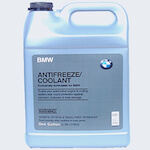Mini Cooper Cooling System
There are some automotive repairs you can delay, but when you see the red warning light appear on your dashboard, you should NEVER ignore it. It is more than a nuisance, it is indicative of an urgent problem in the cooling system of your Mini Cooper.
The engine in a Mini should never run hotter than 210 degrees Fahrenheit, or 98 degrees Celsius. If the temperature gauge ever climbs beyond the half-way point, then it is starting to “run-hot” and could reach these dangerous temperatures very quickly.
Factory Approved Coolants
One simple solution to an overheated Mini engine is that you might be using the wrong coolant, or outdated, expired coolant. The manufacturer recommends specially formulated coolants for your Mini, rather than the cheap stuff you buy at the discount automotive store like Dexcool. Straight tap water is also not recommended. Use a coolant that meets Mini Cooper factory specifications, so as to prevent even further damage to your engine and add to the cost to repair a Mini coolant system.

At German Cart Depot we use the Mini Cooper Long Life Coolant, which is a G48 coolant and is also known as BMW N 600 69.0. This coolant meets the specific factory specifications set forth by Mini and BMW. It contains no phosphates or nitrites, and is extremely hard to find “off-the-shelf.” This coolant is engineered to protect the seals and metals within the cooling system, and is extremely effective in warm climate that we enjoy in Southern Florida.
Flush the Radiator
A hot-running Mini could be due to could be radiator problems, such as corrosion in the radiator, lime scale in the housing, or other foreign pollutants clogging the system. You can prevent this by following the recommended mini cooper maintenance schedule <link>, specifically Inspection II <link>, which recommends flushing the system every two to four years. Many owners prefer to change more often, especially those who live in warmer climates like Florida.
Cooling Fans
There are two cooling fans in a Mini. One is located right behind the radiator and help chill the coolant and water that is traveling through it. The other is behind the air-conditioning condenser. Each is powered by a small electric motor. If one or more of these motor’s fails, then the coolant and radiator can slowly begin to heat up. This can then lead to broken seals due and other internal failures.
Cooling Temp Sensors and Thermostats
The cooling temp sensors can also experience electrical or mechanical failure, and then incorrectly display the temperature within the engine. This could lead to an engine becoming overheated, without the driver even knowing it, until it is too late.
The thermostat in a Mini begins to open at 89-92° C (192° F – 198°F) and is fully open at 103° C (217° F). Sometimes it can get stuck, and then make your Mini run hot.
Water Pump and Hoses
Just like the heart pumps blood, the water pump helps push the vital coolant through the engine. They are made with plastic impellers, and as the car ages this plastic can become brittle and break. They then can spin off the shaft and block the flow of the coolant. Water pumps can also fail due to problems within the thermostat, radiator, head gasket, or loose or worn hoses. If you see any leaking coolant, or hear strange noises within the cooling system, the water pump could need replacement.
Mini Repair Cost
The best way to save money on repairing your Mini is to adhere to the maintenance schedule. This will include regular inspection of the entire cooling system, including the hoses, fittings, radiator, coolant fans, fan clutch, water pump, and fans. Should you require repairs, contact us at German Car Depot for an inexpensive alternative to dealerships.